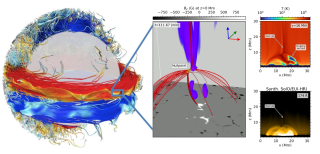Bibcode
Cheung, Mark C. M.; Martínez-Sykora, Juan; Testa, Paola; De Pontieu, Bart; Chintzoglou, Georgios; Rempel, Matthias; Polito, Vanessa; Kerr, Graham S.; Reeves, Katharine K.; Fletcher, Lyndsay; Jin, Meng; Nóbrega-Siverio, Daniel; Danilovic, Sanja; Antolin, Patrick; Allred, Joel; Hansteen, Viggo; Ugarte-Urra, Ignacio; DeLuca, Edward; Longcope, Dana; Takasao, Shinsuke; DeRosa, Marc L.; Boerner, Paul; Jaeggli, Sarah; Nitta, Nariaki V.; Daw, Adrian; Carlsson, Mats; Golub, Leon; The
Bibliographical reference
The Astrophysical Journal
Advertised on:
2
2022
Journal
Citations
40
Refereed citations
36
Description
Current state-of-the-art spectrographs cannot resolve the fundamental spatial (subarcseconds) and temporal (less than a few tens of seconds) scales of the coronal dynamics of solar flares and eruptive phenomena. The highest-resolution coronal data to date are based on imaging, which is blind to many of the processes that drive coronal energetics and dynamics. As shown by the Interface Region Imaging Spectrograph for the low solar atmosphere, we need high-resolution spectroscopic measurements with simultaneous imaging to understand the dominant processes. In this paper: (1) we introduce the Multi-slit Solar Explorer (MUSE), a spaceborne observatory to fill this observational gap by providing high-cadence (<20 s), subarcsecond-resolution spectroscopic rasters over an active region size of the solar transition region and corona; (2) using advanced numerical models, we demonstrate the unique diagnostic capabilities of MUSE for exploring solar coronal dynamics and for constraining and discriminating models of solar flares and eruptions; (3) we discuss the key contributions MUSE would make in addressing the science objectives of the Next Generation Solar Physics Mission (NGSPM), and how MUSE, the high-throughput Extreme Ultraviolet Solar Telescope, and the Daniel K Inouye Solar Telescope (and other ground-based observatories) can operate as a distributed implementation of the NGSPM. This is a companion paper to De Pontieu et al., which focuses on investigating coronal heating with MUSE.
Related projects

The Whole Sun Project: Untangling the complex physical mechanisms behind our eruptive star and its twins
The Sun is a magnetically active star with violent eruptions that can hit Earth´s magnetosphere and cause important perturbations in our technology-dependent society. The objective of the Whole Sun project is to tackle in a coherent way for the first time key questions in Solar Physics that involve as a whole the solar interior and the atmosphere
Fernando
Moreno Insertis

Numerical Simulation of Astrophysical Processes
Numerical simulation through complex computer codes has been a fundamental tool in physics and technology research for decades. The rapid growth of computing capabilities, coupled with significant advances in numerical mathematics, has made this branch of research accessible to medium-sized research centers, bridging the gap between theoretical and
Daniel Elías
Nóbrega Siverio